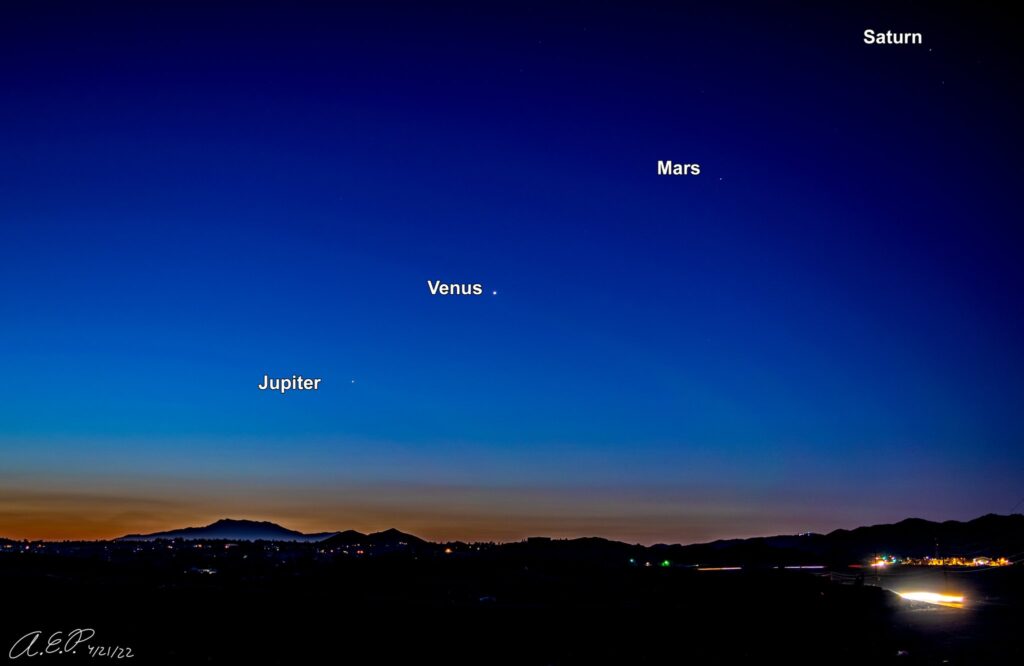
Stargazers around the world are heading in to the backyard this month to catch a glimpse of a quartet of bright planets–Venus, Mars, Jupiter, and Saturn–clustered in the predawn sky. In addition to the pretty view, astronomers enjoy a boost to their mental health and well-being, and so could you!
In a recent study, 84% of participants agreed that spending time in nature helped them cope with the pandemic (Robinson 2021). “Spending time in nature” encapsulates a lot of experiences that everyone has access to, like visiting a local park, going on a scenic drive, or sitting at the beach. These simple activities can lead to amazingly positive outcomes for people still feeling down from the pandemic. It’s the simple, direct connection to nature you’re looking for, and stargazing is just one example that gives the broad benefits.
Being in nature can have a large, positive effect on mental health and well-being. It increases “nature connectedness,” attention span, positive feelings, and one’s ability to reflect on a life problem (Berto 2014). It decreases negative emotions and the negative cognitive impacts of stress (Mayer 2009). Experiencing nature can be one of the tools we can use to overcome the negativity and stress the pandemic has caused us all.
It is well documented that the COVID-19 pandemic has caused a sharp increase in mental health conditions worldwide. During the pandemic, sensitive groups experienced up to a 50% increase in mental health conditions as well as self-reported loneliness. Meanwhile, stay at home orders produced a 60% decrease in time spent in nature, on average. Recently, studies have correlated the increase in depressive symptoms and decrease in life satisfaction, in part, to the decline in nature connectedness (Young 2022) (Wanberg 2020).
Another symptom of COVID is the loss of social connectedness from social distancing practices that physically disconnect us from the members of our community. According to another recent study, people who spend the least amount of time outdoors have the lowest perceptions of social cohesion. Those who spend more time in local natural settings, like parks, have a better sense of community (Cox 2018). They are able to share their positive experience in a natural space with their neighbors, facilitating the sense of community lost to so many who became isolated under the stay at home orders. In the study, there was no need for conversation or interactions between people to facilitate the sense of community, although that did increase the feeling further.
These studies were broad, but all came back to the concept of establishing “nature connectedness.” This is an important need for everyone, yet the last time we made it part of our communal routine was recess. In urban environments, “experiencing nature regularly appears to be the exception rather than the norm (Cox 2017).” The standards of urban life embrace how disconnected we are from nature: hours of traffic every day, high-rise condos with every amenity, workaholic lifestyles, late-night debauchery. Where does nature fit in?
Right now, it doesn’t. Therefore, we will need a societal shift to see this balance brought back to the lives of urban populations. Encouraging people to seek out natural spaces and reprioritize how they spend their time will be especially hard for the people who currently don’t spend any time in nature.
Luckily, our local green spaces are not lacking. From bodyweight fitness equipment alongside jungle gyms, to the pedal boats at Echo Park Lake–there is something for everyone across both the city and county Recreation and Parks departments. We have the green spaces in place, now we need to get people to use them!
The first step should be a media campaign that acknowledges and takes back the two years of messaging that demonized public spaces and passing strangers. Although social distancing was only ever about exposures longer than 15 minutes, some people became afraid of simply walking past a stranger. Social distancing and stay at home orders solidified anti-social habits that have had a lasting impact on time spent in nature even after the orders have ended. People need to be encouraged to be outside and maintain whatever distance they need to be comfortable and safe. Social distancing should become be a practice that encourages people to return to their community and allows safe outdoor events and casual outings to take place. People need to know it is absolutely safe to be in public spaces as long as they do it properly. The fear needs to be removed from their thoughts. We can even use this post-COVID messaging to encourage some people to go out even more than they did pre-COVID.
Next, people need to be encouraged to visit green spaces by the institutions they are already part of. Schools and businesses should set aside time to encourage their students and employees to visit local green spaces. Simple examples could be a field trip to, or a lunch potluck at a nearby park. Adding just a few well-publicized, voluntary events in natural spaces would be a positive, social experience, especially for people who never go. People should not be forced, although it would be good for most, some would be uncomfortable or even fearful of these situations and need to take it at their own pace. Let them see how controlled, safe, and fun it is for their classmates or coworkers, and eventually they’ll join in.
Community events that are outdoors, organized, and social distanced can be impactful as well. One option could be a community stargazing night in a local park with a wide open view of the night sky. Communities are suffering, and bringing them together to enjoy a green space and make memories will bring mental health benefits and societal healing for the entire urban population.
References:
Robinson, J. M., Brindley, P., Cameron, R., MacCarthy, D., & Jorgensen, A. (2021). Nature’s Role in Supporting Health during the COVID-19 Pandemic: A Geospatial and Socioecological Study. International journal of environmental research and public health, 18(5), 2227. https://doi.org/10.3390/ijerph18052227
Mayer, F. S., Frantz, C. M., Bruehlman-Senecal, E., & Dolliver, K. (2009). Why Is Nature Beneficial?: The Role of Connectedness to Nature. Environment and Behavior, 41(5), 607–643. https://doi.org/10.1177/0013916508319745
Wanberg, C. R., Csillag, B., Douglass, R. P., Zhou, L., & Pollard, M. S. (2020). Socioeconomic status and well-being during COVID-19: A resource-based examination. Journal of Applied Psychology, 105(12), 1382-1396. doi:http://dx.doi.org/10.1037/apl0000831
Cox, D. T. C., Shanahan, D. F., Hudson, H. L., Fuller, R. A., & Gaston, K. J. (2018). The impact of urbanization on nature dose and the implications for human health. Landscape and Urban Planning, 179, 72–80. doi:10.1016/j.landurbplan.2018.07.013
Berto R. (2014). The role of nature in coping with psycho-physiological stress: a literature review on restorativeness. Behavioral sciences (Basel, Switzerland), 4(4), 394–409. https://doi.org/10.3390/bs4040394
Young, D. R., Hong, B. D., Lo, T., Inzhakova, G., Cohen, D. A., & Sidell, M. A. (2022). The longitudinal associations of physical activity, time spent outdoors in nature and symptoms of depression and anxiety during COVID-19 quarantine and social distancing in the United States. Preventive medicine, 154, 106863. https://doi.org/10.1016/j.ypmed.2021.106863
Cox, D. T. C., Hudson, H. L., Shanahan, D. F., Fuller, R. A., & Gaston, K. J. (2017). The rarity of direct experiences of nature in an urban population. Landscape and Urban Planning, 160, 79–84. doi:10.1016/j.landurbplan.2016.12.006

